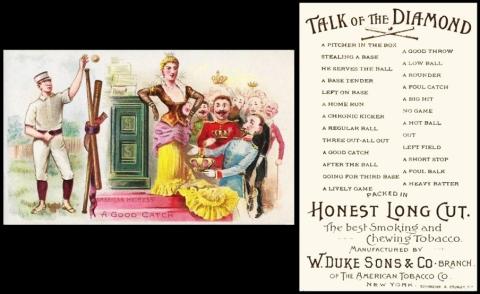
Here we have a most unusual set that a lot of collectors, even baseball ones, know nothing about. The stumbling block seems to be the title, for it sounds like jewellery. It is only when you see the card, with its baseball player to one side, that the penny, or maybe the ball, starts to drop.
On the other side to the baseball player, separated by a bat, is a comical image which takes a phrase commonly used in baseball and applies it to another meaning - so in this case we have "A Good Catch", the sporting meaning of which is when a player catches a ball in his hand, especially if it was unexpected that he would be able to do so.
However, in our drawing, a lady has caught herself a royal suitor, and he is going to far as to offer her his crown. Americans always seem to believe that catching themselves some kind of royalty makes up for the fact that their life with them will probably be very dull, and the love quite lacking, sometimes on both sides. It is also rather telling that in their set of "Habitations of Man" the English are represented by a castle. Sadly, this is still the case with many high profile marriages, which have come to include members of social media "royalty"; however, the truth still remains that a better match is often found with someone closer to home, where the money may be tight, but the friendship and maybe even love, makes up for all of that.
This set is described in our original World Tobacco Issues Index as :
TALK OF THE DIAMOND. Lg. A.T.C. back. Bkld (25). Ref. USA/135 ... D76-44
If we head over to Jefferson Burdick`s American Card Catalogue, the set is listed as :
135 - Talk of the Diamond (25) comics
This is almost certainly why there is no mention of baseball in our reference books either, for much of the American card details were extracted from Jefferson Burdick`s findings. As he did not mention baseball, and probably did not supply an actual card, just his wordings, the connection was not made on our side of the Atlantic. Today, with the internet, this kind of error is way less likely to occur, as we can simply scan a card and include it. That was not so easy in the 1950s when this great work was being compiled.
And, by the way, Jefferson Burdick values them at 40 cents a card
